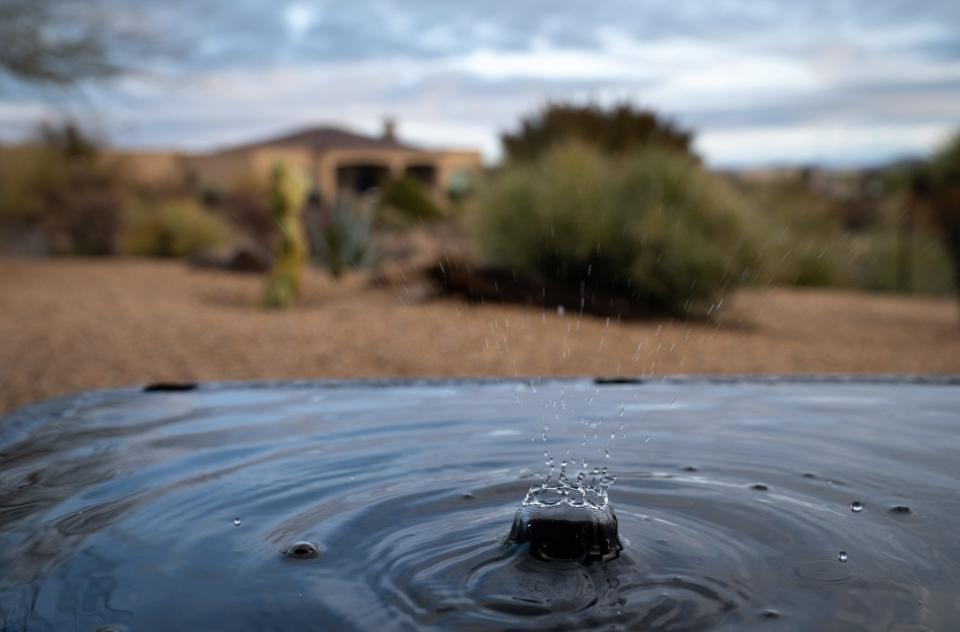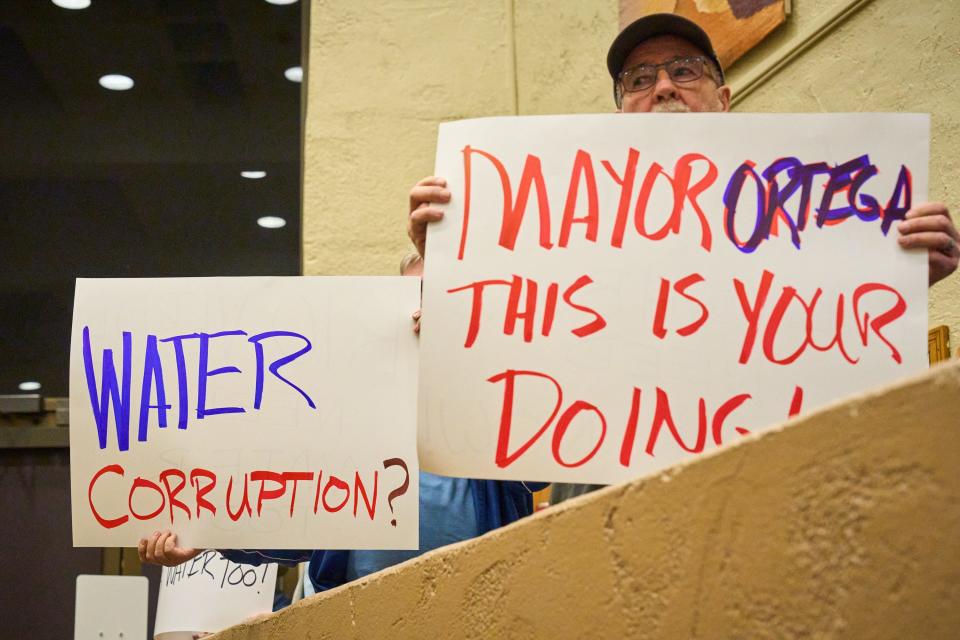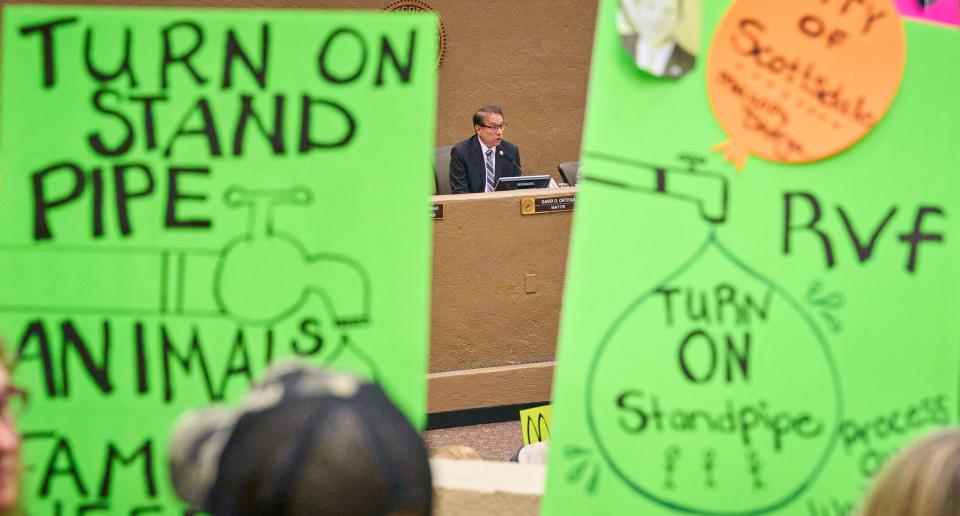A community without water: What to know about Rio Verde Foothills
It's been nearly three weeks since residents of a northeast Valley community lost their main source of water.
For years, Scottsdale has warned that it would eventually cut off water hauling to Rio Verde Foothills, a patchwork of roughly 2,000 homes nestled just outside city limits.
Last year, it set a deadline. About 500 of the community's homes — 1,000 people — rely on hauled water, and the city informed those property owners that they would need to find another water source by 2023.
Despite months of work and disagreements among neighbors in pursuit of solutions, that deadline came and passed with no plan — and Scottsdale turned off the taps. Now, residents are in a crisis and bitterly divided.
As the situation continues to unfold, here are a few things to know about the community and its water woes.
'Wildcat' development: Why Rio Verde Foothills doesn't have guaranteed water

Rio Verde Foothills is an unincorporated community, meaning it is not within the boundaries of a city. That makes it far out of reach of municipal water pipes.
Instead, the area is simply part of Maricopa County, which oversees large swaths of land that aren't under a city or town government. Residents pay less taxes in these areas but don't receive the same services as city residents. For instance, the county doesn't buy or provide water like cities do because it isn't authorized to act as a water provider under state law.
Instead, if developers build subdivisions on county land, they must secure water and prove that the community has enough to last 100 years.
But some developments across the county and state fall into a loophole in the law. There, developers split properties fewer than six times to build new homes, meaning the houses aren't technically inside of subdivisions. And that means private property owners never had to prove a 100-year water supply.
These types of developments are called “wildcat” subdivisions, and Rio Verde Foothills is a textbook example. Essentially, some homes there were built without any regard for residents' water future. And because the groundwater there is spotty, not all residents have the option of just drilling a well.
If the community is on county land, why is Scottsdale involved?

For decades, Scottsdale provided water to residents who relied on hauling. The city did so via a standpipe a few miles from the community near the intersection of Jomax and Pima roads.
There are no pipes that go all the way to Rio Verde Foothills, so the standpipe serves as the primary way to get water close to the community. As a result, most interim and some permanent solutions to the community's water issues depend on Scottsdale's cooperation.
What water can the community temporarily access?

Private haulers can still provide some water to the community through sources beyond Scottsdale — mostly, other municipalities.
But those sources are unstable and can stop doing business with the water haulers at any time, leaving the community dry.
Most of the cities that will provide water to haulers are farther away from Rio Verde Foothills. That means haulers have to spend more time and diesel to get water into residents' tanks, so costs have skyrocketed.
Are there any long-term options to get water to the area?
There are several potential options, but none has yet come to fruition.
One was a proposal to create a water taxing district, but that plan was unanimously voted down in August by the Maricopa County Board of Supervisors. Supervisor Tom Galvin, who represents the district encompassing Rio Verde Foothills, said he had concerns about the long-term viability of the body and its potential costs.
Instead, Galvin favored a long-term agreement with private water utility Epcor. That potential solution is currently in the works, but since the company is regulated by the state, the plan first must go through Arizona's Corporation Commission.
The cheapest and fastest option to provide residents with water, according to a letter from Epcor to the Corporation Commission, is for the company to use Scottsdale's treatment facility and pipes.
Other proposals are more complicated. One would see Epcor drill a new well, add arsenic treatment, build a standpipe and construct a separate water storage facility, to the tune of $10 million before water costs.
If Epcor gets approval to serve the area, the company estimates it will take at least 24 to 36 months before a permanent solution is fully in place. It also notes the ideas that involve Scottsdale depend on the city's approval.
Why is Scottsdale opposed to helping?

Scottsdale Mayor David Ortega has repeatedly called himself a "hard no" on helping Rio Verde residents, saying that water isn't "a compassion game."
To back that up, he's expressed concern over ongoing drought conditions on the Colorado River.
He's also opposed allowing any water serving Rio Verde Foothills residents to flow through the city's water treatment plant and pipes, citing the impacts of water hauling trucks on Scottsdale roads and saying the city gave the county and Rio Verde Foothills residents ample notice that it wouldn't provide water or infrastructure forever.
Scottsdale officials haven't commented much on the pressure they're facing from Rio Verde Foothills residents and other politicians to negotiate a deal that would ensure the community has a stable temporary source of water. But they have said that the city "remains firm in that position, and confident it is on the right side of the law."
Why would residents build and buy homes in the community, given the water issues?
Many residents have said they weren't adequately informed about the water problems before purchasing or building their homes.
Most said they were informed they would have to rely on hauled water. But they said they were assured that hauling water was common in Arizona and that Scottsdale never would cut off access to its standpipe.
Even when Scottsdale began threatening to cut off the community's water, many residents said they didn't believe it actually would happen without a permanent solution in place.
"I never thought, after 20 years of running water, that Scottsdale would cut us off," said John Hornewer, owner of Rio Verde Foothills Potable Water Hauling and a resident of the community. "I just never thought that."
Is Rio Verde Foothills the first community in Arizona to lose its water?
The community's water woes are similar to that of New River, an unincorporated community north of Phoenix that faced a dilemma in 2017 when that city cracked down on water haulers who were taking water from city hydrants to deliver to their properties.
There, Epcor was able to step in to build a hauling station and provide water. But the Rio Verde Foothills situation is slightly more complex. Epcor doesn't already have a water supply ready to go there, as it did in New River, and residents' water issues are happening against a backdrop of drought on the Colorado River.
Rio Verde Foothills may not be the only community at risk of losing its water supply. "Wildcat" subdivisions have been built across the state and county, meaning other areas may face similar challenges as cities implement their drought restriction plans and tighten their water usage.
Sasha Hupka covers Maricopa County, Pinal County and regional issues for The Arizona Republic. Do you live on unincorporated land and have a story to tell? Reach her at [email protected]. Follow her on Twitter: @SashaHupka.
This article originally appeared on Arizona Republic: Arizona community without water: What to know about Rio Verde Foothills
